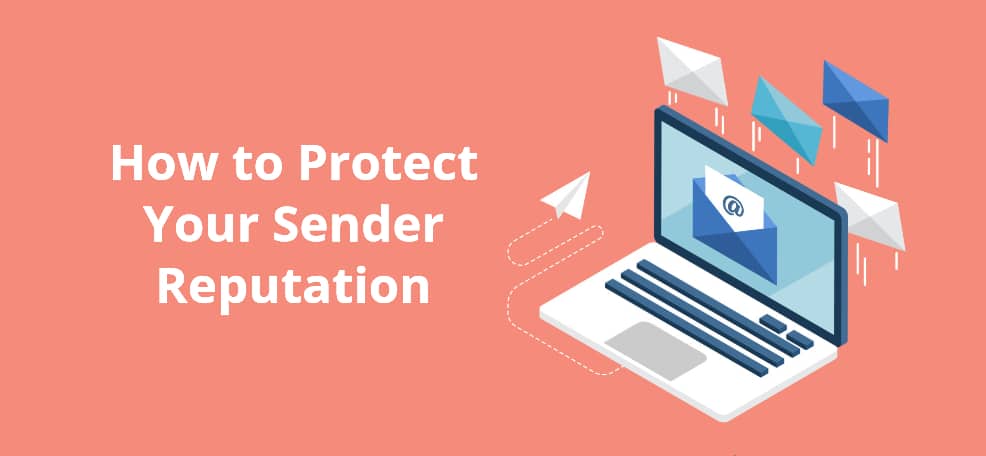Despite the belief that emails are a thing of the past, studies show that an email marketing campaign is still the best way to generate leads, alongside direct customer engagement, social media, and opt-in pop-ups. However, as good as your emails might be, they aren’t going to be doing much for your business if they are not reaching their intended recipients.
This is why you need to understand the importance of your sender reputation and how to protect your sender reputation.
But before we jump into that, what is Sender Reputation?
What is Sender Reputation?
In short, your sender reputation is a score assigned to you by an ISP (Internet Service Provider). This score is your be-all, end-all: if it’s high, your emails are delivered safely. If they fall below a certain threshold, they are classified as spam and in the worst case scenario… Your emails are rejected outright and are not delivered at all. Your sender reputation is determined by a variety of factors, including, but not limited to:
- The number of emails you send
- How many recipients mark your emails as spam
- How many recipients complain about your emails
- How often do your emails trigger the ISP’s spam trap
- Are you included on any blacklists
- How many emails are bounced back to you
- What is your open rate, click rate, conversion and unsubscribe rate
- What is your subscriber engagement like
Based on all these factors and more, some not necessarily made public, ISPs assign you with your sender reputation score and it will rule your email marketing campaign. Your success is entirely dependent on keeping your sender reputation score above a certain threshold.
The factors listed above will definitely damage your sender reputation and this article is intended to arm you with the knowledge to fight back against anything that could harm your sender reputation.
Clean Your List!
If you look at the list of causes above, you will find that nearly all of them can be sidestepped if you clean your email list.
It is very likely that not all the email addresses on your list are valid and of the ones that are valid, it is likely that not all of them actually engage with your emails. These emails will cause issues like you ending up sending a vast number of emails, of which many are invalid and many more which will never be opened, clicked on or engaged within any other way. Further, the invalid emails will be bounced back, which will harm your IP reputation score.
Another point to consider is that people who don’t engage with your emails and still find that you are sending emails to them will either unsubscribe or worse, lodge a complaint. The former will affect your domain authority and the latter is a straight stab at your sender reputation.
All of these issues can be very deftly avoided if you take the incentive and clean your email lists. Cleaning your email list will leave you with a list of contacts who are all valid and are likely to engage with you – and as long as the valid emails and consistent engagement are maintained, your sender reputation will be unharmed. It will even grow over time if you manage your campaign well.
Boost Your Campaign!
The simple truth is that your sender reputation, domain authority, IP reputation – all of these will organically improve if you send emails to people who will actually engage with your emails. But you can also try to increase the engagement of your campaign. So take steps to boost your engagement rates and do yourself the favor of both securing your sender reputation and the strength of your campaign.
The good thing is that there are many ways to do this easily and effectively. You can explore ways and take the necessary steps to increase your open rates – there are a variety of categories of subject lines that you can explore to catch your recipient’s attention.
You should also be doing segmenting for your lists, which allows you to only send emails that are relevant and valuable to your possibly thousands and thousands of subscribers. Naturally, by only sending content that is meaningful to them and aligned with their tastes and needs, you increase the likelihood of them opening your emails and interacting with them. In addition to segmentation, you should also be doing targeting and retargeting.
Targeting and retargeting are both processes which ensure you send the right email to the right person at the right time, by monitoring their activities. If you are a chocolatier, doing something as simple as sending an email titled “25% Discount on Dark Chocolate” when you notice they’ve visited your website looking for Dark Chocolates will immediately have a positive effect on your campaign and thus your sender reputation.
These are things you should be doing with your campaign anyway, and they come with the nice advantage of also improving and solidifying your sender reputation score.
Know Your Customers!
It goes without saying that taking into account the human nature of your customers will also benefit you. At every step of the way, you should be focused on building trust with them. You can enhance your campaign’s success and further protect your sender reputation by knowing your customers. Finding out what they like and dislike about your marketing strategy will allow you to address their concerns before they unsubscribe.
You can do this by employing a survey email and perhaps giving your subscribers an incentive to actually do the survey by offering them a chance to win something by completing the survey. As a nice bonus, the data you gain from the survey can be used for more than adjusting to your strategies to protect your sender reputation. You can use this data to segment your email list more accurately and target your subscribers effectively.
Ideally, you can use a feature-rich opt-in system like the one provided by Poptin to create an opt-in pop-up that will collect a few details about the customers right off the bat. Poptin allows you to design different pop-ups for different visitors by monitoring their behavior and target using a number of different methods. A system like this will allow you to get important details as subscribers sign up so that you can send emails that are relevant to them from the beginning of the campaign.
Any email marketer should keep a sharp eye on their metrics to ensure that they are going the right way with their email marketing campaign. As such, one of the key metrics you should be watching is your sender reputation. If the others, like open rates or conversion rates, go down, you will be able to take action relatively easy. If your sender reputation goes down and you are unable to send emails, you will be stuck in a paradoxical position you don’t want to be in.
Keep the above points in mind when you are monitoring your campaign, cultivate a respectable sender reputation score and ensure that you achieve the success you deserve for your email marketing campaign.




